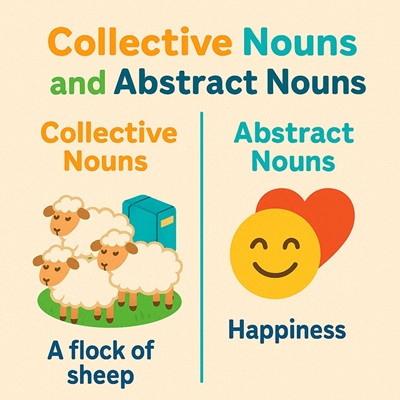Introduction to Abstract Nouns
Abstract nouns are words that name ideas, qualities, states, or feelings that cannot be seen, touched, or measured. They are intangible and exist only in our minds. Unlike concrete nouns, which refer to physical objects, abstract nouns represent emotions, concepts, or experiences.
For example, happiness, freedom, and love are abstract nouns because they describe feelings or ideas rather than things we can see or touch.
Examples of Abstract Nouns
- Emotions: joy, anger, sadness, fear, excitement, disappointment
- Qualities: bravery, honesty, kindness, wisdom, patience, creativity
- States: peace, chaos, freedom, poverty, childhood, sleep
- Ideas: justice, democracy, success, failure, knowledge, courage
Rules for Using Abstract Nouns
- Abstract nouns are usually uncountable: You cannot say “a happiness” or “two justices.” Instead, use phrases like “a feeling of happiness” or “a sense of justice.”
- They often follow adjectives: Abstract nouns are frequently used with adjectives, such as “great wisdom,” “deep love,” or “immense bravery.”
- They can be formed from other words: Many abstract nouns are derived from verbs or adjectives. For example:
- Honest → Honesty
- Brave → Bravery
- Decide → Decision
Do’s and Don’ts for Abstract Nouns
✅ Do use abstract nouns to express emotions and concepts clearly: “Her kindness touched everyone in the room.”
✅ Do combine abstract nouns with descriptive adjectives: “He showed remarkable patience in handling the situation.”
❌ Don’t use abstract nouns where concrete nouns are needed: Instead of “She showed intelligence in her answers,” it is clearer to say, “She answered wisely.”
❌ Don’t pluralize uncountable abstract nouns incorrectly: Say “much knowledge,” not “many knowledges.”
Introduction to Collective Nouns
Collective nouns are words used to describe a group of people, animals, or things as a single unit. Even though they refer to multiple individuals or objects, they are treated as singular nouns.
For example, a team of players, a flock of birds, or a bunch of bananas are collective nouns because they describe a collection rather than individual items.
Examples of Collective Nouns
- People: team, class, family, audience, committee, crew
- Animals: herd of cows, pack of wolves, swarm of bees, school of fish
- Things: bundle of sticks, fleet of ships, bouquet of flowers, pile of books
Rules for Using Collective Nouns
- They are usually singular: A collective noun is treated as singular when it refers to the group as a single entity. Example: The team is practicing for the match.
- They can be plural in some cases: When referring to individual members of the group, use plural verbs. Example: The team are arguing among themselves.
- Some collective nouns have special names: Groups of animals often have unique collective nouns, such as:
- A pride of lions
- A gaggle of geese
- A parliament of owls
Do’s and Don’ts for Collective Nouns
✅ Do use collective nouns to simplify sentences: Instead of “the students in the class,” you can say “the class.”
✅ Do choose the correct verb form: “The herd is grazing” (singular) vs. “The herd are scattering” (plural, referring to individual members).
❌ Don’t mix singular and plural verb forms incorrectly: Saying “The family are happy” is incorrect unless emphasizing individuals within the group. Instead, say “The family is happy.”
❌ Don’t confuse collective nouns with plural nouns: “A group of birds” is correct, but “a birds” is incorrect.
Conclusion
Abstract nouns and collective nouns are essential parts of English grammar. Abstract nouns help us express feelings, ideas, and states of being, while collective nouns allow us to describe groups efficiently. Understanding these concepts will improve sentence structure and clarity in writing. By following the rules and guidelines above, students can use these noun types effectively in their writing and speech.

















